-
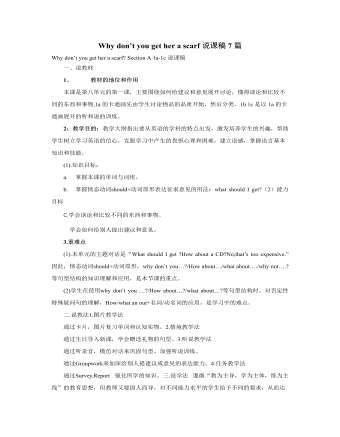
人教版新目标初中英语八年级下册Why don’t you get her a scarf说课稿7篇
[设计意图: 该环节可让学生展示自我,拓宽运用英语能力,把所学的知识在实际交流中进行运用,实现新课程倡导的“为用而学, 在用中学,学了就用”,从而提高学生综合运用英语的能力。选择母亲节来临为母亲选择礼物这一话题也是借此机会对学生进行感恩教育,并在学生的热烈讨论中告诉学生gift can’t be everything, everything can be a gift.使学生的情感得到升华。] Step9 Summary T: What have we learned in this class? Presents/ Gifts Comments Suggestions Album----special Why don’t you … Bicycle----useful Why not … +V原形 Calendar----interesting How about … Scarf----personal What about … +V-ing/ 名词 [设计意图:此环节的设计,有助于理清脉络,进一步巩固所学知识。] Step10 Homework 1. listen to 1b (do 1b and imitate ) 2. Write down your dialogue 3. Surf the internet about the differences of gift giving between China and foreign countries. [设计意图:作业1听力,由于1b听力和后面的2a相似,所以课堂上不再重复做,将其留做课后作业,上课下课时刻关注学生听力能力的培养和训练。2是将学生课堂上的说落实到课后的写。3是让学生通过自主学习,了解中西方文化的差异。分层次布置作业,体现出因材施教的教学理念。]
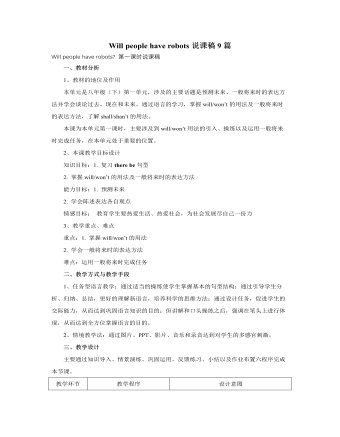
人教版新目标初中英语八年级下册Will people have robots说课稿9篇
(一) 导入新课(1’)运用多媒体课件,播放有关机器人的视频,引起学生共鸣,激发学生学习兴趣。 边看边展示与课文相关的新单词。让学生想像机器人都是什么样的,机器人能做什么?(这样导入新课,自然创设学习情景,引起学生共鸣,引起学生的兴趣。)(二)快速阅读(skimming)(4’)任务:让学生带着要求快速阅读课文:Get the main idea of the whole passage.这个环节是让学生初读课文,目的是训练快速阅读技巧,学生以较快的速度完成阅读,迅速找到答案。(学法指导:注意:用浏览、跳读和快读的技巧,培养自己快速获有用信息的能力---抓住关键词、主题句和中心大意的能力。Tips: Reading for meaning , not for details(细节).不必逐行阅读(三)深层阅读(5’)任务一:默读文章,回答下列问题,我利用多媒体出示2个问题,(把2个问题打出来)然后让学生带着问题进行有目的阅读。(这样做可以充分利用课本资源,而且化难为易.在全班校对答案之前我让学生先进行同桌相互校对,充分发挥生生互动。)

人教版新目标初中英语九年级上册Teenagers should be allowed to choose their own clothes教案2篇
Step 1 Greeting Greet the class and check the homeworkStep 2 A duty report The S on duty gives a report on the rules in his home and lead in 3a “Sun Fei’s and Wu Yu’s rules” Step 3 ReadingSs read the conversation and write the two girls’ rules in the chart. Check the answers.Get Ss to read after the tape and then read aloud by themselves. Then, T explains the language points.Step 4 Pairwork 3bRole play. Use the information in chart to practice with the conversation in 3a covered. They can look at the sample conversation in the right box.Step 5 Task 2 “Who’s the best reporter?”Make a survey by asking any 5 students the questions in the chart in activity 4. Then give out a report about it. See who is the best reporter? And the best reporter will get a nice ball-pen.Step 6 Summary and homework:Write out the report in your exercise-books.Period ThreeStep 1 Greeting and a duty reportThe S gives a duty report talking about his experience of being late for school. Lead in the question “Do you ever get to school late? How often do you get to school late? Always, usually, sometimes, or never?Step 2 1a Get Ss to finish writing.Step 3 Pairwork 1b Get Ss to talk about their answers with their partners using the sample conversation in the box on the right.Step 4 Listening practice2a Lead-in: What will happen if you get to school late? What about Peter? Let’s listen to a conversation between Peter and his father. Get Ss to finish 2a (As usual, for the first time, Ss only listen.) Check the answers.
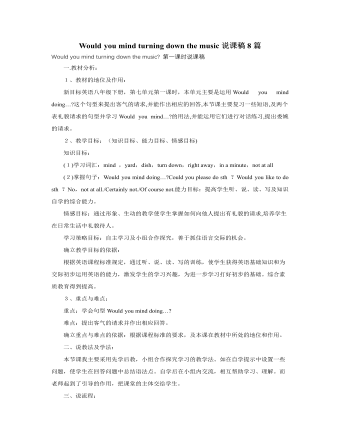
人教版新目标初中英语八年级下册Would you mind turning down the music说课稿8篇
一.教材分析: 1、教材的地位及作用:新目标英语八年级下册,第七单元第一课时,本单元主要是运用Would you mind doing…?这个句型来提出客气的请求,并能作出相应的回答,本节课主要复习一些短语,及两个表礼貌请求的句型并学习Would you mind…?的用法,并能运用它们进行对话练习,提出委婉的请求。2、教学目标:(知识目标、能力目标、情感目标)知识目标:(1)学习词汇:mind ,yard,dish,turn down,right away,in a minute,not at all(2)掌握句子:Would you mind doing…?Could you please do sth ?Would you like to do sth ?No,not at all./Certainly not./Of course not.能力目标:提高学生听、说、读、写及知识自学的综合能力。情感目标:通过形象、生动的教学使学生掌握如何向他人提出有礼貌的请求,培养学生在日常生活中礼貌待人。学习策略目标:自主学习及小组合作探究,善于抓住语言交际的机会。

人教版新目标初中英语九年级上册How do you study for a test教案2篇
内容提示本单元主要内容是学会利用verb十by/with gerund表示方式方法来讨论学习英语的策略,认识自己在学习方面的长处和不足。初步了解现在完成时的结构和用法。现在完成时由助动词have/has+动词的过去分词构成,主要表示过去发生的某一动作对现在仍有影响或造成的后果,常与already,yet,just,ever,never等副词连用。教学目标一、学习目标(Language Goal) 1. Talk about how to study . 学会讨论各种学习方法和策略。2. Find out your suitable learning methods. 找出适合自己的学习方法。 二、语言结构(Language Structures) 1. Verb + by with gerund by+动名词短语 表示“通过…途径,方法” 2. How questions have引导的特殊疑问句 三、目标语言(Target Language) 1. How do you study for tests ? 你是怎样准备考试的?Well , I study by working with my classmates. 哦,我和同学们一起学习。2. Have you ever studied with a group ? 你曾经参加过学习小组吗?Yes , I have . I’ve learned a lot that way . 是的,参加过。通过这种方式我学了许多。

人教版新目标初中英语九年级上册Where would you like to visit教案2篇
The First PeriodⅠ.Teaching Aims and DemandsKnowledge Objects(1) Key Vocabularytiring, educational, fascinating, thrilling, peaceful, exotic, trek, jungle, take it easy, explore, historic, site(2) Target LanguageWhere would you like to go on vacation?I’d like to trek through the jungle, because I like exciting vacations.2. Ability Objects(1)Train students to talk about places they would like to visit with the target language.(2)Train students to describe vacations with different adjectives.(3)Train students' listening skill.3. Moral Object,It′s more interesting to go on vacating somewhere instead of staying at home.Ⅱ. Teaching Key Points1. Key Vocabularytiring, educational, fascinating, thrilling, peaceful, exotic, trek, jungle, take it easy, explore, historic, site2. Target LanguageTalk about different places with the target language.Ⅲ. Teaching Difficult Points1. Describe vacations with different adjectives.2. Talk about different places with the target language.Ⅳ. Teaching Methods1. Teaching by illumination2. Teaching by doing chain drills3. Teaching by pairworkⅤ. Teaching Aids1. A tape recorder2. Some pictures of different places with famous views
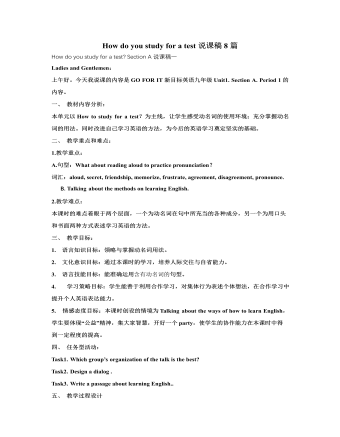
人教版新目标初中英语九年级上册How do you study for a test说课稿8篇
教学反思:这是学生升入初三的第一节课,学生学习热情很高,通过这一课时的学习,学生掌握了语言目标中所要求的知识重点、难点和语言技能,如by dong, practicing doing ,too……to,现在完成时态,动名词短语做主语及提建议的几种方式,但是有部分学生由于基础较差,还需要从培养学生学习兴趣入手,真正实现教育面向全体学生。在教学中采取的具体办法由:个别辅导,互助学习,留不同层次夫人作业,争取让每一位学生都吃饱而不掉队。How do you study for a test?Two periodsSection BGoals●To listen about learning English●To talk about learning English●To read about learning EnglishProceduresWarming up by reading to the recordingHello, everyone. To begin with, let’s listen and read to the recording of the text HOW DO YOU LEARN BEST? That is, read aloud to the tape, as fast as the tape goes, as clearly as the native reader reads. OK? Here we go!My cat speaks English. Sometimes my cat comes to me and tells me that she is hungry. Or that her leg hurts. How does my cat tell me these things? I don't speak pussy-cat language.1a Reading and checkingLearning English can be both easy and difficult. What things are easy for you? And what things are difficult for you? Now turn to page 5, read the list on the top and check √the statements that are true for you.1b Making a listYou have read and checked the statements true for you. Now think and make a list of other things difficult for you, too.
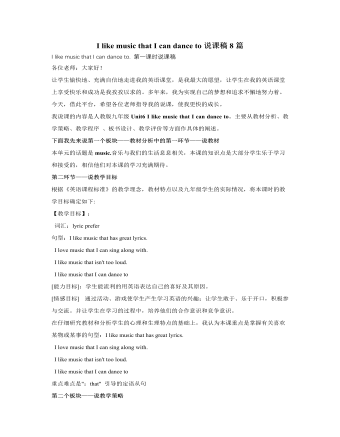
人教版新目标初中英语九年级上册I like music that I can dance to说课稿8篇
2、 难点结合功能句进行听力练习。确定目标的根据新课程标准规定,通过听、说、读、写的训练,使学生获得英语基础知识和初步运用英语进行交际的能力,激发学生的学习兴趣,为进一步的学习打基础。此外,根据我国国情及新课程标准的要求,现阶段英语教学的素质主要包括思想素质教育,潜在英语能力的培养,非智力因素的培养等几个方面。而我们班的学生本身英语基础不太好,部分学生已经对英语失去了信心,还有一部分学生觉得英语越来越难,渐渐力不从心了,不感兴趣了,上课注意力也不集中了。针对这种情况,备课时要增加趣味性,以此来提高学生对英语的学习兴趣。二、教法学法1、 教法:采取“任务型”教学法。教师根据本节课内容,安排合适的任务,让学生在完成任务的过程中达到本节课所拟定的目标。
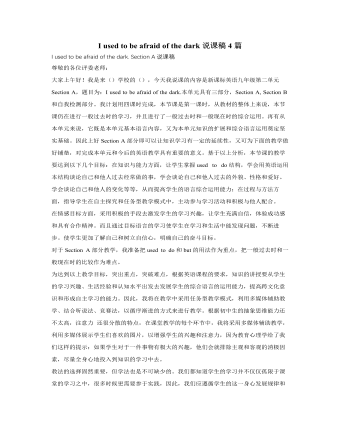
人教版新目标初中英语九年级上册I used to be afraid of the dark说课稿4篇
2、说说写写通过读写训练,进一步学会用 used to 结构来表达自己和同伴过去害怕,或现在仍旧害怕的事情,并且要把最后的结果书写下来,然后让他们将结果用英语告之其他同学,为学生创造展示才能的机会。这样能使全体同学都积极参与,集中精力认真听。既巩固了本节课的目标语言,又为下一个环节3b的对话打下基础。活动结问题比较容易,英语基础较差的学生也能够独立完成,因此,在检查答案是尽量让这部分学生回答,使他们体验到成功后的喜悦,提高他们学习英语的兴趣。 3.对话练习:让学生两人一组,模仿3a中的对话,根据提供的信息与提示词进行对话练习,目的在于对新学的目标语言进行口头练习与设定情景中的运用。为学生创造展示才能的机会。推荐两至三组的同学到教室前面,就所编的对话进行角色表演。

人教版新目标初中英语九年级上册Teenagers should be allowed to choose their own clothes说课稿6篇
二、教材分析本课时主要是以听和说的方式来谈论一些家庭和学校的“规矩和制度”,知道那些时可以做的,那些是不可以做的,让学生先从口头上了解这些规矩和制度,为后面的学习做好准备。三、教学的目的和要求1. 掌握短语be strict with sb.的用法,并介绍be strict in sth.的用法;2. 学生能够根据所学的知识,了解用什么方式/句型来制定规章制度。3. 多听,提高学生的习愿望,敦促学生开口说英语,用本课所学的知识来表达自己的意见。四、教学重点和难点1. 如何正确使用be allowed to do…这一句型(在不同时态中的被动语态运用)。2. 如何获得听力技巧及口语技能的提高。五、教学过程T—teacher S—studentS s—students Bb—blackboardStep 1 Warming up Check their homework first, and see if the Ss can make sentences by using the rules in 4, Section A. If possible, try to give some help.
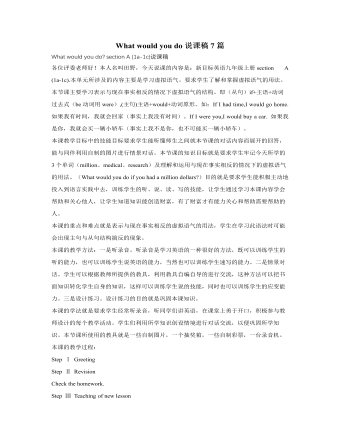
人教版新目标初中英语九年级上册What would you do说课稿7篇
Get students to complete the activity in groups of four. As the groups work together, move around the room to make sure students discuss the topic in English and know how to fill in the chart.Check the answers by asking different pairs of students to say their conversations to the class.Answers will vary.Optional activityAsk, What would you do if there were no classes tomorrow? Ask students to write as many answers as they can. Then get students to work in pairs. One ask the other the question and see how many new answers the other is able to think of.Step Ⅴ SummarySay, In this class, we've done a lot of reading, speaking and writing practice using the target language.Step Ⅵ Homework(1) Review the target language by reading the conversations in Activity 3a.(2) Finish off the exercises on pages 11~12 of the workbook.Step Ⅶ Blackboard DesignWhat would you do?Section AThe Third PeriodTarget language:A: I can't sleep the night before an exam. Then I'm too tired to do well. What should I do?B: If I were you, I'd take a long walk before going to bed. That should help you relax.A: I really want a dog, but my parents won't let me have one.B: Well, dogs can be a lot of trouble. Maybe you should get a small pet, like a goldfish.A: That's a good idea.

人教版新目标初中英语九年级下册We’re trying to save the manatees教案2篇
本单元主要围绕着有关濒临灭绝的动物这一话题,学习了应该怎样保护我们的环境,以及就某一问题展开辩论。目标提示语言目标能够运用所学知识,就某一问题展开辩论。认知目标1、复习一些语法:现在进行时、一般现在时、用used to 表示一般过去时、现在完成时、一般过去时的被动语态。2、学会表达同意和不同意。3、学会以下基本句型:We’re trying to save the manatees.Manatees eat about 100 pounds of food a day.There used to be a lot of manatees.In 1972,it was discovered that they were endangered.Some of the swamps have become polluted.情感目标了解一些濒临灭绝的动物的生活习性和濒临灭绝的原因,教育学生应该如何保护环境。教学提示充分利用多媒体等教学设备,创设与本课话题相关的情境,如各种不同种类的动物、动物园以及有关环境的画画等等。围绕着本单元的教学目标,设计一些贴近学生实际的教学任务,如让学生谈论自己最喜欢的动物,如何拯救濒危动物,如何保护环境等等。让学生根据所学知识,就动物园是否对动物有利以及其他的话题进行辩论。
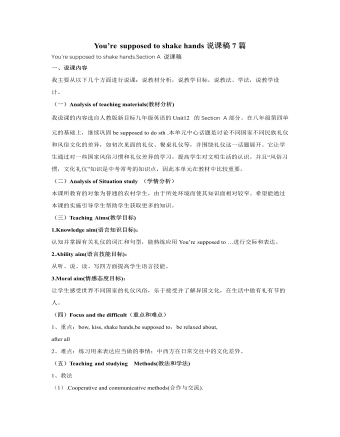
人教版新目标初中英语九年级下册You’re supposed to shake hands说课稿7篇
二 、教材分析本单元主要是通过对一些国家的风俗习惯、礼仪差异、时间观念和饮食文化的学习,进一步提高学生对文明生活的认识;加深学生对中外文化的了解,拓展学生的文化视野,为学生阅读相关方面的文章奠定一定的文化基础。我们知道近几年来有关风俗文化,生活习惯的 阅读内容一直是中考热门的话题之一。通过本单元的学习,学生可以掌握一定的相关方面的知识,为今后在阅读积累必要的信息。在Section A 当中出现的 be supposed to 句型为重点句型,此句型的语法结构为被动语态。被动语态也是历年来中考基础命题必考的内容之一。比如,去年的中考试题,在基础选择部分试题中就出现了对此语法结构考查。Section A 首先通过一些图片和句型来让学生初步了解本单元的语言目标。然后,通过练习进一步加以巩固。接着通过一组听力练习,来训练学生的听力,同时,学生可以具体了解到不同的国家在风俗习惯等方面有着怎样的不同。为下面的学习进行铺垫,同时激发学生了解更多的相关知识的学习兴趣。

人教版新目标初中英语九年级下册When was it invented说课稿7篇
《新目标英语》中的具体语言目标是通过各种各样的Tasks来实现的;学生需要运用具体而特定的行动来完成一定的交际任务。整个教学过程中,各种语言结构与语言功能与不同的学习任务有机的结合。任务活动所谋求的效果不是一种机械的语言训练,而是侧重在执行任务中学生自我完成任务的能力和策略的培养;重视形式在完成任务过程中的参与和在交流活动中所获得的经验。因此本节课我将始终引导学生通过完成具体的任务活动来学习语言,让学生为了特定的学习目的去实施特定的语言行动,通过完成特定的交际任务来获得和积累相应的学习经验,让学生在用中学,在学中用。 2、教学原则 l 活动性原则 提倡学生主动参与,体验,交流,合作,探究等多种学习。 l 合作性原则 以学生为主体,师生合作,生生合作,体现教与学的互动,交往。 l 任务型原则 任务驱动—激发动机;任务完成—激励学习积极性;执行任务—培养责任 心和合作精神。 l 情感性原则 激发学生学习英语的兴趣和始终保持良好的学习情绪。
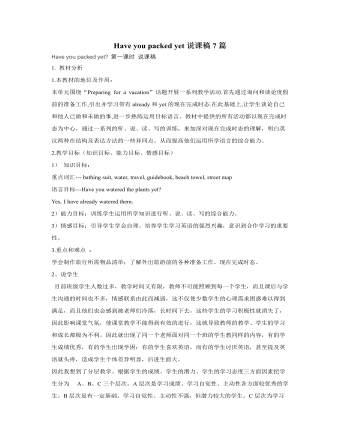
人教版新目标初中英语九年级下册Have you packed yet说课稿7篇
二 说学情 “以学生的发展为本”的新课程理念,要求教学必须以学生的学习基础、学生需要、学习兴趣等为出发点,联系学生的现代校内外生活,让课堂教学成为学生生命成长和个性张扬的过程。要实现以“学生为本”的理念,教学中必须要做到充分地预设学情。初三学生已经具备了一定的语言基础及语言表达能力,大部分学生对英语还有着比较浓厚的兴趣。同时,在长期的新课程理念熏陶及实践中,已经初步具备了自主,合作,探究的能力。本课教学内容与学生的实际生活密切相关,易于引发学生运用简单的英语进行交际和交流。通过八年级下册第九单元“Have you ever been to an amusement park?”的学习,学生已初步了解现在完成时的基本特征和结构,也比较熟悉“has/have been to…”的句型,这非常有利于本单元教学活动的开展。在此基础上,本单元以“Preparing for a vacation”和“Favorite band”等贴近学生实际生活的内容为话题,继续学习带有already与yet的现在完成时态,较快地激发学生的学习积极性,达成本单元的教学目标。
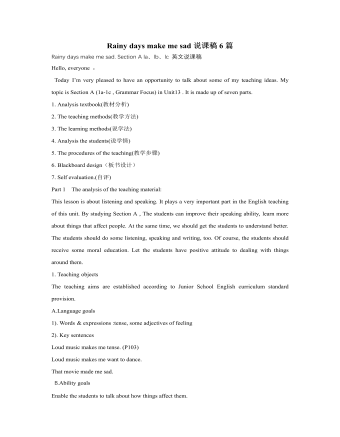
人教版新目标初中英语九年级下册Rainy days make me sad说课稿6篇
Today I’m very pleased to have an opportunity to talk about some of my teaching ideas. My topic is Section A (1a-1c , Grammar Focus) in Unit13 . It is made up of seven parts.1. Analysis textbook(教材分析)2. The teaching methods(教学方法)3. The learning methods(说学法)4. Analysis the students(说学情)5. The procedures of the teaching(教学步骤)6. Blackboard design(板书设计)7. Self evaluation.(自评)Part 1 The analysis of the teaching material:This lesson is about listening and speaking. It plays a very important part in the English teaching of this unit. By studying Section A , The students can improve their speaking ability, learn more about things that affect people. At the same time, we should get the students to understand better. The students should do some listening, speaking and writing, too. Of course, the students should receive some moral education. Let the students have positive attitude to dealing with things around them.1. Teaching objectsThe teaching aims are established according to Junior School English curriculum standard provision.A.Language goals 1). Words & expressions :tense, some adjectives of feeling 2). Key sentences Loud music makes me tense. (P103)Loud music makes me want to dance.That movie made me sad.B.Ability goals Enable the students to talk about how things affect them.Emotion & attitude goals Enable the students to understand the effect of things upon them.
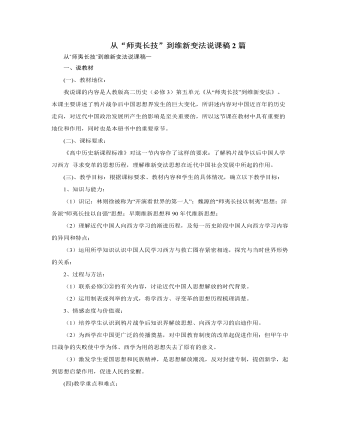
人教版高中历史必修3从“师夷长技”到维新变法说课稿2篇
(一)、教材地位:我说课的内容是人教版高二历史(必修3)第五单元《从“师夷长技”到维新变法》。本课主要讲述了鸦片战争后中国思想界发生的巨大变化,所讲述内容对中国近百年的历史走向,对近代中国政治发展所产生的影响是至关重要的,所以这节课在教材中具有重要的地位和作用,同时也是本册书中的重要章节。(二)、课标要求:《高中历史新课程标准》对这一节内容作了这样的要求:了解鸦片战争以后中国人学习西方 寻求变革的思想历程,理解维新变法思想在近代中国社会发展中所起的作用。(三)、教学目标:根据课标要求、教材内容和学生的具体情况,确立以下教学目标:1、知识与能力:(1)识记:林则徐被称为“开演看世界的第一人”;魏源的“师夷长技以制夷”思想;洋务派“师夷长技以自强”思想;早期维新思想和90年代维新思想;

人教版高中历史必修2战后资本主义的新变化说课稿2篇
2.“里根经济学”和“撒切尔主义”20世纪70年代,世界资本主义经济发展进入“滞胀”状态后,各国政府纷纷寻找医治这一新疾病的药方,其中影响最大的是供应学派和货币学派。1979年,撒切尔夫人上台担任英国首相,率先采纳了货币学派的主张。1981年,里根担任美国总统后,以供应学派为依据,确立了自己政府的经济政策。由于两人的经济政策都在一定程度上缓解了本国的经济危机,并有一套理论体系支撑,因此经济学家们分别称之为“里根经济学”和“撒切尔主义”。实际上,“里根经济学”和“撒切尔主义”有许多相同之处,二者都提倡自由放任,强调市场调节作用,反对国家干预;二者都实行有利于富人的减税政策,因此都曾被攻击为“劫贫济富”;二者都大力增加军费开支,用加大政府消费来缓解危机。3.美国“新经济”战后西方国家在凯恩斯主义指导下,暂时摆脱了三十年代那种严重的大萧条局面,但由于长期实行扩张性财政货币政策和对社会需求进行管理的政策,各资本主义国家经济又出现新的危机,即“滞胀”(生产停滞和通货膨胀),凯恩斯主义由此走向没落。

人教版高中历史必修2战后资本主义的新变化教案2篇
1、知识与能力:(1)识记:20 世纪 50 ~70 年代国家干预经济的政策、 70年代的经济“滞胀”“混合经济”;福利国家;第三产业的蓬勃发展;“新经济”的出现;(2)理解当代资本主义的新变化的实质是资本主义的自我扬弃,是在资本主义内部的自我改善,是资本主义生产关系的自我调整;(3)掌握以美国为代表的主要资本主义国家在战后的经济发展历程,分析各国经济发展的共同原因。2、过程与方法:(1)引导学生利用教材和相关史料,培养归纳、再现历史事件的能力,提高学生的历史思维能力;通过讨论提高学生的思辨能力,培养学生全面客观地分析问题的思维方式。(2)学生通过观察1977年发达国家国有经济比重表,懂得提取有效信息、分析数据的能力;(3)学生通过思考讨论西方福利制度的利弊,培养全面、客观分析和比较历史现象,辩证地观察和分析历史问题的能力。
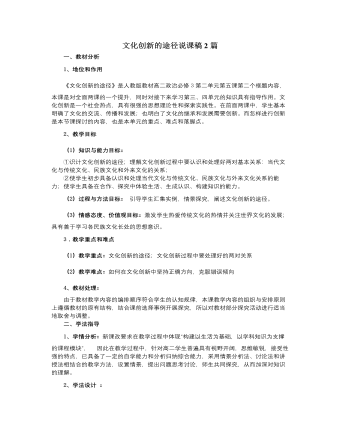
人教版高中政治必修3文化创新的途径说课稿2篇
PPT:文化创新的途径环节二:(展示情境 探究问题)情境一:先后展示徐悲鸿的《奔马图》和《愚公移山》设计意图:在作品的选择上遵循由易到难,由感性到理性的原则让同学们从中体会作者的创作情怀,比较两幅图表达的心境不同之处及其原因。探究一:从创作背景的不同,探究文化创新的根本途径。PPT:(设问)1、为什么同一画家在不同时期,作品所反映的内容不同?2、从中我们可看出,文化创新的根本途径是什么?设计意图:引导学生分析时代的变化对人们的社会实践的影响,因而文化工作者在体验生活的过程中创作的作品意境也会不同,培养学生透过现象看本质的能力,得出文化创新的根本途径是社会实践。教师过渡:在社会实践中,徐悲鸿先生还有什么创作的成功秘诀吗?探究二:从创作心得的展示,探究文化创新的重要途径(PPT)徐悲鸿一生致力于国画的创新实践,他认为革新中国绘画的要旨在于:“古法之佳者,守之;不佳者,改之;垂绝者,继之;未足者,增之;西方画之可采入者,融之。” 设计意图:通过阅读材料,培养学生寻找关键词的能力,并从中总结归纳文化创新的重要途径----继承传统、推陈出新。

